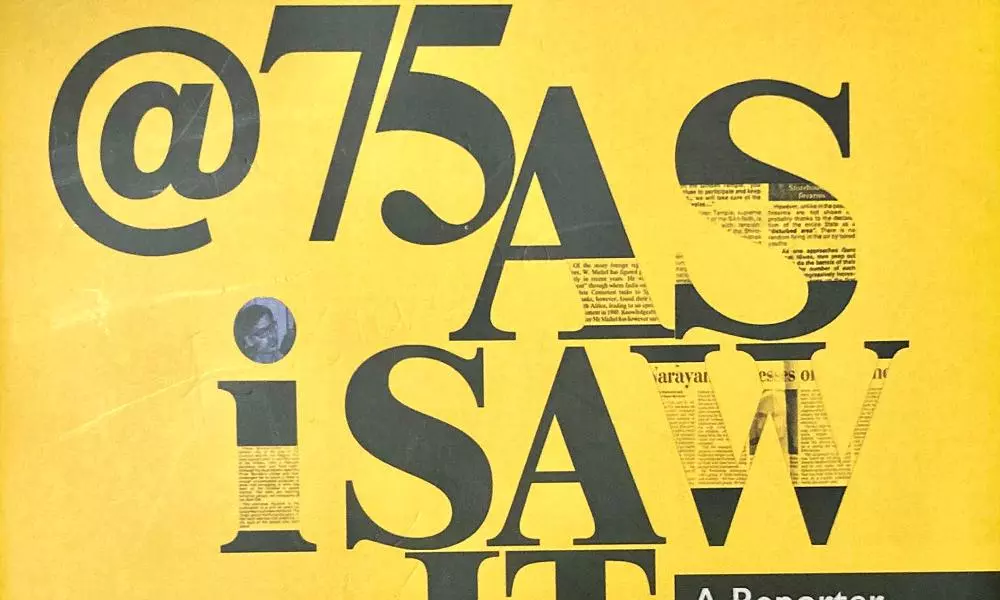Book Review | A reporter’s diary with thrilling stories only a newsman can tell

Kahan ke Ved ho? (You are a Ved from where?)” Prime Minister Charan Singh had asked journalist Mahendra Ved who at that stage was working for the wire agency UNI.
Ved had replied cheekily, “Chaudhry sahab, mein panchvan Ved hun (I am the fifth Veda). The tall, lanky, extremely dapper journalist belonged to an era when easy cordiality between India’s leaders and journalists was possible. Stories were reported more often than not, from the eyes of the common man and not from those of the uber-rich.
Mahendra recently celebrated his 75th birthday by penning his memoirs, @75 As I Saw It, a quintessential reporter’s diary packed with coverage of wars and assassinations, of riots and meetings with Prime Ministers and film stars.
I first met Mahendra Ved at a party in the late 1990s. He was already a big name in journalism and I was fascinated with his stories of late Bangladesh Prime Minister Sheikh Mujib’s killing, of the 1971 war and the “troubles” in Afghanistan.
Written in typical racy reporter’s language, Ved speaks of the visit of a Pakistani trade delegation to Dhaka in the first week of August 1975 which may have been involved in the final planning of the coup d’etat and killings which shook the world a fortnight later.
He writes and I quote: “The visit was coordinated by Maj. Gen. M.I. Karim, an officer with experience in intelligence operations in the Pakistan Army, repatriated to Bangladesh after the Liberation War (in 1971).”
Karim arranged the Pakistani delegation’s meetings with Khandekar Mustaq Ahmed, the then commerce minister in Mujib’s Cabinet who was later made the figurehead president of Bangladesh after the assassination.
Ved writes that “details which later trickled out indicate that Karim discussed the coup plans with Mustaq and the majors (killers of Sheikh Mujib). By August 8, they were finalised.”
He also hints at the complicity of the CIA and recounts how a lady officer posted at the US embassy was seen dancing with Major Shariful Huq Dalim, the man who would announce the coup to the world over Dhaka radio after seizing it, just days before the event.
He also speaks of the killing of a senior RAW officer who went by the name of P. Nath in a Dhaka hotel in mysterious circumstances, months before the coup. Of Nath, whose real name was Phanindranath Banerjee (an IPS officer who had earlier organised meetings between Mujib and Mrs Indira Gandhi in 1966 in London), Ved says: “His death was not natural, but there was no follow-up. An intelligence sleuth, he knew Mujib from his student days in Calcutta. He warned Mujib.”
He quotes another well-known Bangladeshi journalist-turned diplomat on the plot being first born, sometime in June 1974, at a meeting of two of the killer majors — Syed Faruq Rahman and Khondakar Abdul Rashid — at Gen. Zia ur-Rehman’s house and of a scrap of paper where one of them had doodled details and then torn it up to throw it into a trash can.
“The scrap of paper was collected from the garbage pile by a clerk and passed on to a RAW operative,” Ved writes, adding that the RAW’s famous head, R.N. Kao, subsequently flew down to Dhaka disguised as a betel leaf importer and held a meeting with Mujib in his garden to warn him of the threat to his life, naming the officers involved.
Mujib reportedly waved his hand and said the plotters were like “my own children and would not harm me”.
On August 15, soon after Mujib’s assassination and a terse radio message which announced the new military government headed by Mustaq, a Bangladeshi officer confirmed news of the killings and Ved luckily found his teleprinter lines still working. He pounded out his story which alerted the world of the assassination of Sheikh Mujib.
Five days later Mahendra Ved’s newly wedded wife Naina was packed off home to Calcutta on the first commercial flight to take off from Dhaka after the coup and he slipped in another story on what was going on in post-Mujib Bangladesh on two sheets of tracing paper, hidden in a shopping basket!
Like all reporters’ tales, the book dissects the big events of the time — Sikh militancy, Mrs Indira Gandhi’s death and the advent of the phenomenon called Rajiv Gandhi and the politics after his death.
Having covered some six Prime Ministers for the Times of India, Ved has some juicy tales to share — he recounts how the denial of a Rajya Sabha ticket to Sonia Gandhi’s private secretary Vincent George, by the then Prime Minister Narasimha Rao led to “adroit and persistent intrigues (by the powerful Congress apparatchik) which drove a wedge between Rao and Sonia”.
Ultimately, the intrigues within the Congress led to N.D. Tiwari and Arjun Singh breaking away and forming Congress (T) before the 1996 elections. Both parties fared poorly at the hustings and Rao was voted out of office. A post-election survey showed that the Congress lost 50 Lok Sabha seats due to division of votes.
Ved has an inimitable style and knows how to go beyond politics and intrigue. Writing about a Mumbai party thrown by the star of yester-years Vimi, where he was invited as a reporter who also dabbled in writing on movies, he describes how the then ‘Numero Uno’ of Bollywood, Dilip Kumar, arrived uninvited by simply shouting “mein aa raha hoon (I am coming)” and walking in.
Someone placed a harmonium before him. Ignoring all suggestions, Dilip began singing Mirza Ghalib’s “Tum na aaye toh kya sahar na hui, haan magar chain sey basar na hui.”
Perhaps that one song sums up Mahendra Ved’s five long decades in journalism and his unputdownable reporter’s diary brought out in print.
By Mahendra Ved
India Netbooks
pp. 400; Rs 625

